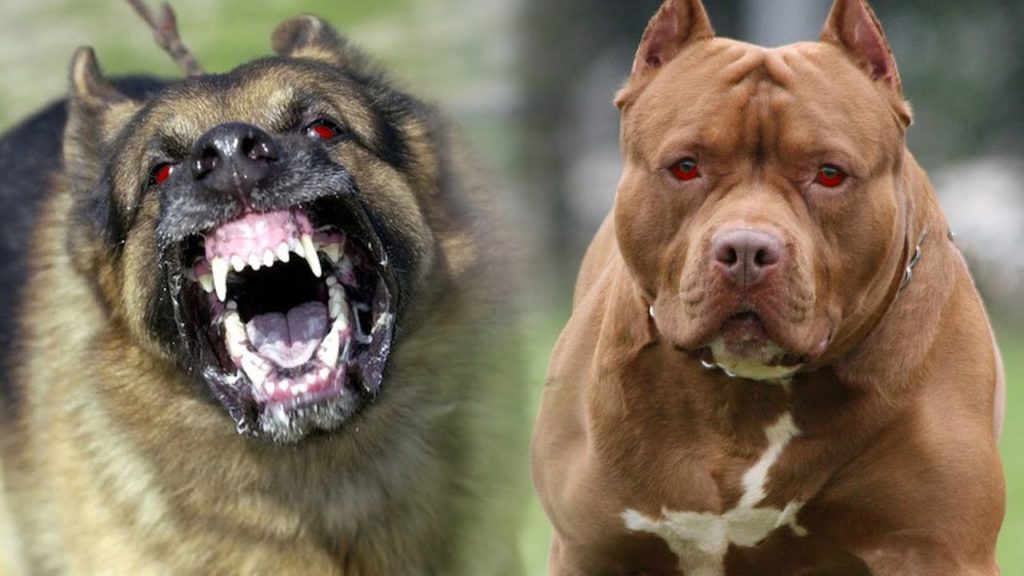
Dogs encompass a wide spectrum of temperaments and behaviors, shaped by factors beyond their breeds. While the term dangerous dog breeds, are commonly used, it’s important to approach this term cautiously. While a dog’s behavior is influenced by genetics, it’s upbringing and training also play an important role. With the right training, even those dangerous breeds can be turned into the ideal companion or guard dog.
In this article, we’ll explore breeds that have earned reputations for being dangerous. As we look at these breeds, we will provide insights into their historical roles, characteristics, and tendencies. By understanding these aspects, we can encourage informed ownership, helping all dogs, regardless of their breed, lead fulfilling and harmonious lives within our communities. Interestingly, these breeds often make great guard dogs.
We will start our list with number 1 being the least dangerous and 10 being the most dangerous. Let’s get cracking
1. Chow Chow
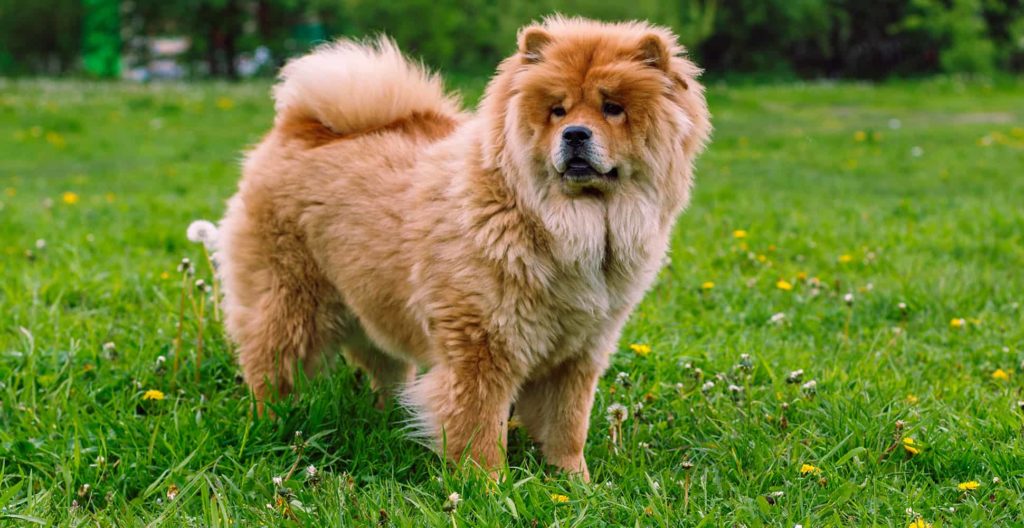
The Chow Chow, with its distinctive lion-like mane and regal demeanor, is a breed that encapsulates a rich history and an enigmatic temperament. Originating from China, the Chow Chow’s roots can be traced back over two millennia, making it one of the oldest dog breeds known to humankind.
Originally bred for various tasks such as hunting, guarding, and even pulling carts, the Chow Chow has played multifaceted roles in Chinese culture. Its name derives from the Cantonese word “chow chow,” which loosely translates to “edible dog.” In the past, parts of the breed were consumed, and its fur used for clothing. However, over time, the breed transitioned from utilitarian roles to becoming cherished companions.
The Chow Chow’s unique appearance, characterized by its thick double coat, distinctive blue-black tongue, and stilted gait, makes it stand out in the canine world. Its aloof and reserved demeanor can often be misinterpreted as unfriendliness, especially by those unfamiliar with the breed’s characteristics. This, coupled with its strong loyalty to its family, adds to the perception of the Chow Chow as a potentially dangerous dog.
The perception of the Chow Chow as a potentially dangerous breed stems from its strong-willed and independent nature. While these traits were once essential for their guarding and hunting roles, they can be challenging for inexperienced owners. The breed’s aloofness and wariness toward strangers, if not properly managed, can lead to defensive behaviors. Moreover, their strong territorial instincts can make them less tolerant of unfamiliar situations and other animals.
It’s important to note that while the Chow Chow may have characteristics that demand careful management, it does not inherently equate to dangerous behavior. Proper socialization, early training, and consistent positive reinforcement are essential to helping Chow Chows become well-adjusted and well-behaved companions. Like all dogs, they thrive in environments where they receive attention, love, and guidance.
2. Doberman Pinscher
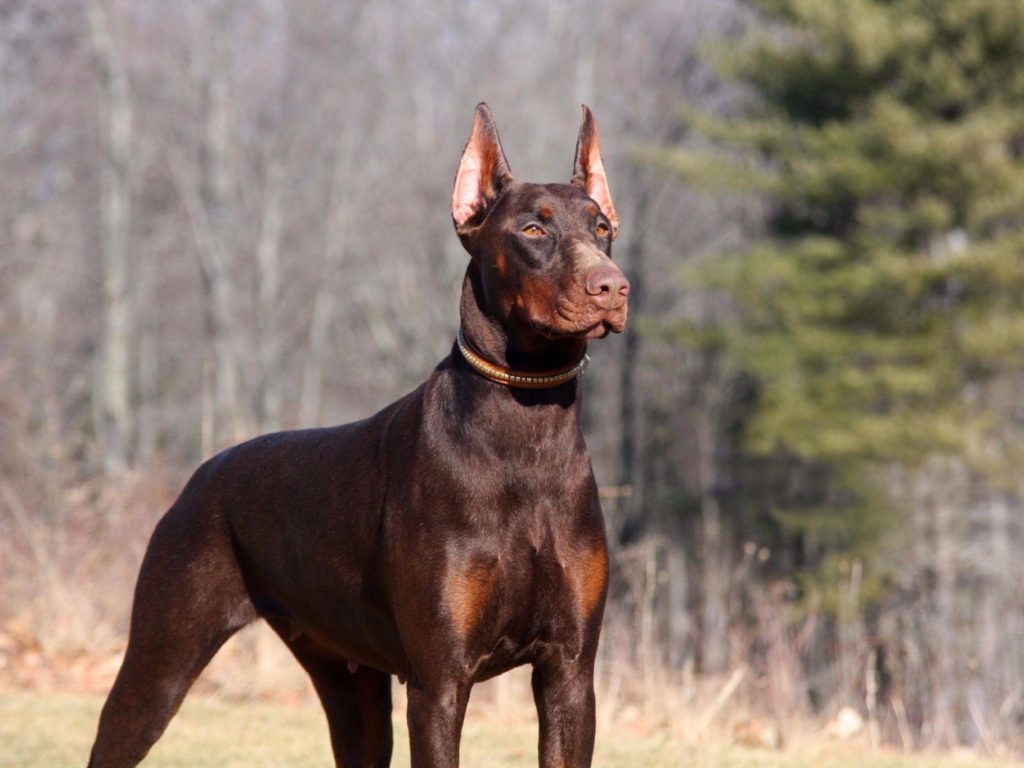
The Doberman Pinscher, often referred to as the “Dobie,” is a breed that exemplifies both elegance and strength. Originating in Germany during the late 19th century, this breed was meticulously developed by a tax collector named Karl Friedrich Louis Dobermann. With a distinct blend of loyalty, intelligence, and physical prowess, the Doberman quickly gained recognition as a versatile working dog and one of the more dangerous dog breeds.
Karl Dobermann’s goal was to create a breed that could serve as a reliable protector and companion. The breed’s foundation includes elements of the Rottweiler, Greyhound, German Pinscher, and Weimaraner, resulting in a dog that excelled in various roles, from guarding and police work to search and rescue.
The Doberman’s sleek and muscular appearance is complemented by its alert expression and cropped ears. Its natural propensity for loyalty and strong bonding with its family members make it a fiercely devoted companion. Its intelligence and adaptability have enabled it to thrive in roles as diverse as service, therapy, and competitive dog sports.
The Doberman’s reputation for aggression and danger largely stems from its historical roles as guard and protection dogs. However, it’s crucial to differentiate between the breed’s potential for protective behaviors and indiscriminate aggression. When properly trained and socialized, Dobermans can be well-mannered and gentle companions. Negative behaviors often arise from inadequate training, social isolation, or poor breeding practices.
To foster a well-behaved and balanced Doberman, early socialization and positive reinforcement training are paramount. Adequate mental and physical stimulation are crucial for channeling their energy constructively. Their natural loyalty and willingness to please their owners can be harnessed through consistent and humane training methods.
Over time, responsible breeding and training practices have led to a shift in the Doberman’s reputation. Many contemporary Dobermans excel as therapy dogs, service animals, and beloved family members. Their instinctual protective nature still shines, but under the guidance of dedicated owners, this trait is tempered with a calm and well-controlled demeanor.
3. Rottweiler
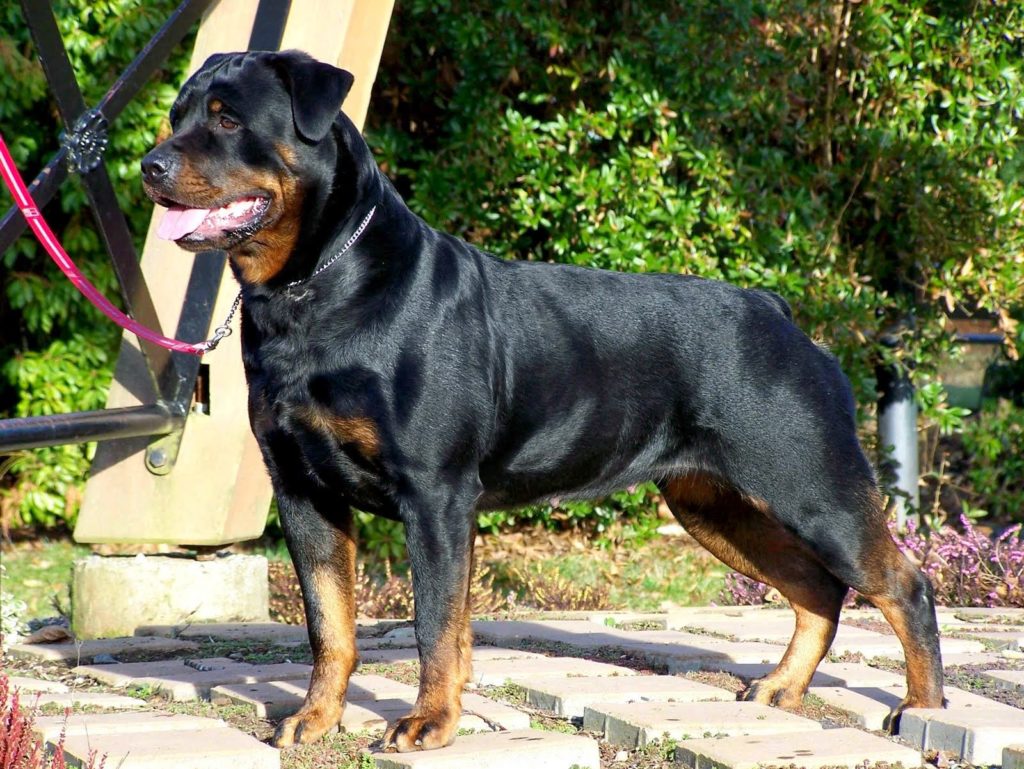
The Rottweiler is commonly regarded by many as one of the dangerous dog breeds in the world.. Originating in the ancient town of Rottweil in Germany, this breed has a storied history as a versatile working companion. Often characterized by its robust physique, Rottweilers have earned a reputation as both protective guardians and affectionate family members.
The Rottweiler’s ancestry can be traced back to the Roman Empire, where they were used as herding and droving dogs, helping to manage cattle and provide security for their handlers. Their resilience and adaptability enabled them to serve in various capacities throughout history, from pulling carts to working alongside police and military personnel.
The Rottweiler’s strong build and distinctive black-and-tan coat contribute to its formidable appearance. Beneath this exterior, however, lies a breed that is known for its loyalty and devotion to its family. Rottweilers often form deep bonds with their owners and are quick to respond when their loved ones are threatened.
The Rottweiler’s reputation for aggression can be attributed to its protective instincts and history as a guardian. Their innate desire to defend their territory and loved ones, combined with their physical strength, has led to concerns about their potential danger. However, it’s important to recognize that any dog’s behavior, including Rottweilers, is shaped by upbringing, socialization, and training.
Responsible ownership plays a vital role in shaping a Rottweiler’s behavior. Early socialization, consistent training, and positive reinforcement help channel their natural protective instincts into appropriate behaviors. Proper exposure to various people, animals, and environments from a young age can mitigate potential challenges related to territorial behavior.
Modern Rottweilers are known for their versatility and adaptability. Many excel in various canine sports, therapy work, and even service roles. While their protective nature remains a prominent trait, their temperament is shaped by their environment and upbringing. Well-bred and properly raised Rottweilers often display a balanced and reliable temperament that aligns with their historical roles.
4. Cane Corso
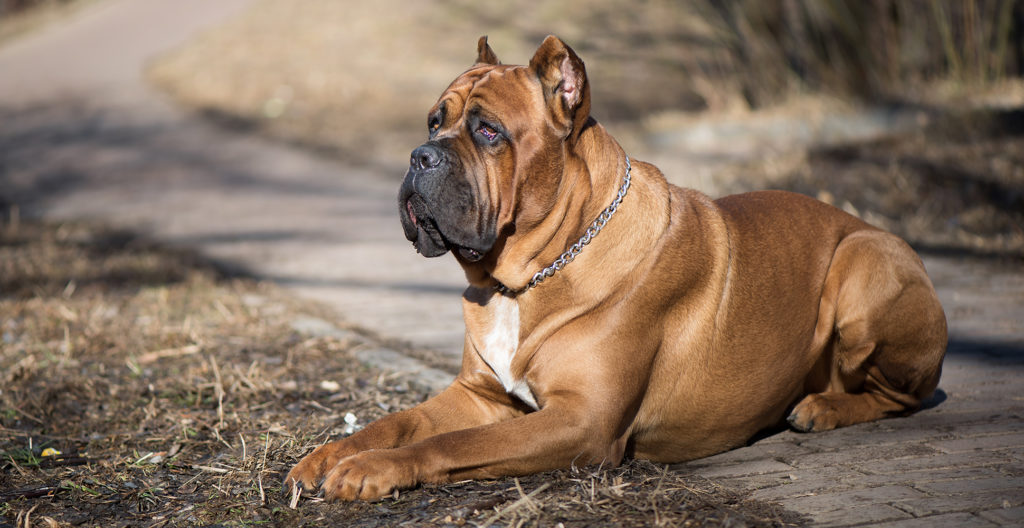
The Cane Corso, often dubbed the “Italian Mastiff,” is a breed that radiates power, elegance, and intelligence. Hailing from Italy, this ancient breed has a lineage that dates back to the Roman Empire, where it was bred for various roles, including guarding, hunting, and assisting in livestock management. Today, the Cane Corso is often featured whenever dangerous dog breeds are being discussed.
Originating in Italy, the Cane Corso’s name is derived from “Cane da Corso,” which means “dog of Corso.” This references the breed’s historical use in the southern regions of the country. The Cane Corso’s versatility allowed it to excel in diverse tasks, from guarding livestock to protecting property and even participating in the hunting of large game.
The Cane Corso boasts a muscular and imposing frame that is accentuated by its short coat, which can come in a variety of colors. Beneath this exterior lies a breed known for its loyalty and protective nature. Cane Corsos are often deeply attached to their families, displaying affection and devotion to those they consider their own.
The Cane Corso’s history as a guardian is a defining aspect of its reputation. With a natural predisposition to protect, they are inherently watchful and alert. Their territorial instincts, combined with their imposing presence, can lead to misconceptions about their potential for aggression. However, like all dogs, their behavior depends on upbringing and training.
Responsible ownership plays a pivotal role in shaping a Cane Corso’s temperament. Early socialization is essential to expose them to various people, animals, and environments. Consistent training, using positive reinforcement methods, helps channel their protective instincts into controlled behaviors, making them well-mannered companions.
Modern Cane Corsos continue to carry their historical traits while adapting to contemporary roles. Many thrive as family companions, therapy dogs, and even participate in dog sports. The breed’s loyalty and affection make them cherished members of households when provided with the right environment, guidance, and care.
5. Tosa Inu
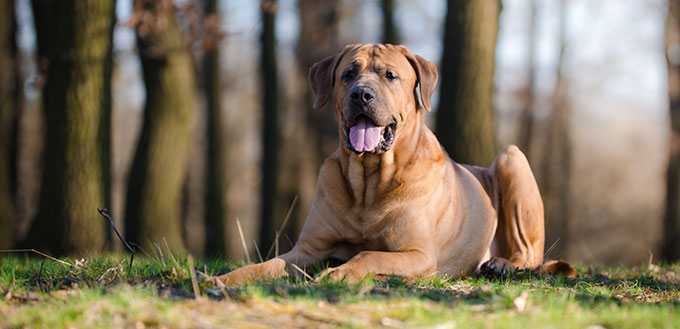
The Tosa Inu, often referred to as the “Japanese Mastiff,” is a breed that emanates a unique blend of strength, dignity, and calmness. Originating in Japan, this imposing breed has a history intertwined with the art of dogfighting and the cultural values of the nation. Despite its formidable appearance, the Tosa Inu possesses a balanced and serene temperament that distinguishes it from other mastiff breeds.
The Tosa Inu’s roots trace back to 19th century Japan, where it was bred by crossing various breeds, including European mastiffs and native Japanese dogs. These carefully selected crosses aimed to create a formidable and skilled fighting dog, known for its size, strength, and tenacity. Despite its history in dogfighting, the modern Tosa Inu is more commonly regarded as a companion and protector.
The Tosa Inu is characterized by its muscular build, impressive size, and short coat, which can be found in a range of colors. What sets the Tosa Inu apart is its composed and dignified demeanor. Unlike other breeds with a similar physical stature, the Tosa Inu is known for its calm and gentle nature, both with its family and in social situations.
The Tosa Inu’s involvement in dogfighting has led to its reputation as one of the dangerous dog breeds. While dogfighting is now largely illegal and widely condemned, the breed’s association with this practice is not easily forgotten. It’s however essential to point out that the Tosa Inu’s behavior, like any breed, can be shaped by its upbringing and training. The right breeding and ownership can help bring out their well-mannered and gentle traits.
Responsible ownership is key in nurturing a Tosa Inu’s balanced temperament. Early socialization is crucial to ensure they are comfortable and well-adjusted in various environments. Positive reinforcement training methods help channel their natural intelligence and eagerness to please into positive behaviors.
The modern Tosa Inus continue to carry their historical legacy while adapting to contemporary roles as family companions and guardians. Their serene and affectionate nature makes them cherished members of households when provided with the right guidance and care.
6. Perro de Presa Canario
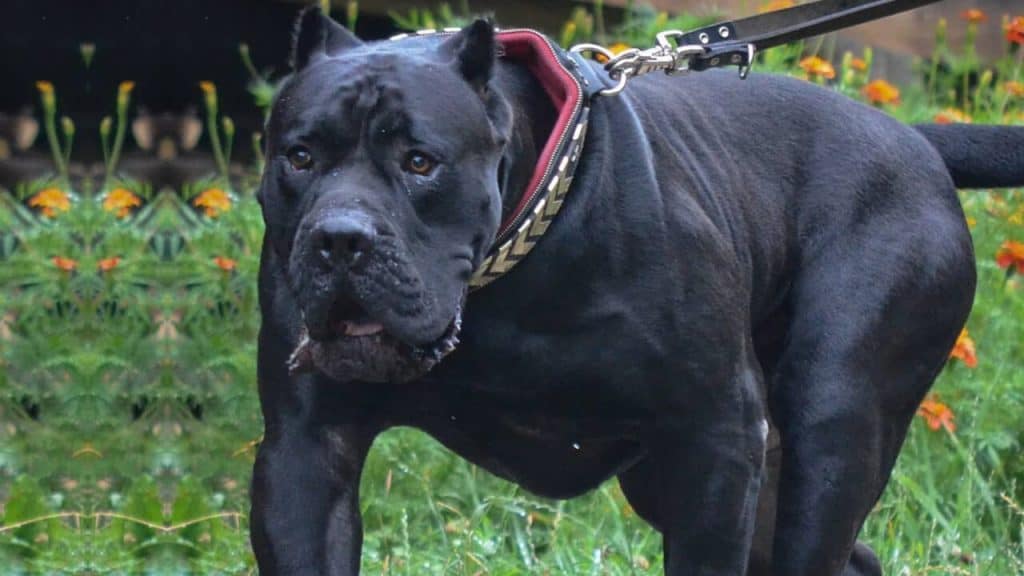
The Perro de Presa Canario, also known as the Canary Mastiff, stands as a symbol of strength, loyalty, and historical significance. A simple look at its physique and facial expression, and you will agree with us for putting it in the list of dangerous dog breeds.
Originating in the Canary Islands, this powerful breed has a history deeply intertwined with livestock management, guarding, and protecting properties. While its imposing appearance may evoke caution, understanding the Perro de Presa Canario’s history and temperament reveals a loyal and dedicated companion.
The Perro de Presa Canario’s roots trace back to the 15th and 16th centuries, where it played an integral role in helping Spanish conquerors and settlers manage their cattle. Their robust build and unwavering loyalty made them excellent working dogs. Over the centuries, the breed evolved to become a dependable guardian, protecting properties from potential threats.
The Perro de Presa Canario boasts a muscular and well-proportioned frame, coupled with a short, coarse coat that comes in various shades. Their appearance exudes strength and determination. While they are renowned for their guarding abilities, they also possess a gentle and affectionate nature toward their family members, forming strong bonds with those they trust.
The Perro de Presa Canario’s protective instincts are deeply ingrained in its history. Their loyalty and territorial nature make them excellent watchdogs. However, these same traits can contribute to their perceived danger if not properly managed. Responsible ownership and training are essential to channel their protective instincts into well-controlled behaviors.
Proper socialization from a young age is crucial for the Perro de Presa Canario to develop appropriate behaviors around other animals and people. Positive reinforcement training methods help establish clear boundaries and guidelines. When provided with consistent leadership and structure, they thrive as devoted companions.
Today, Perro de Presa Canarios are versatile dogs that excel as working dogs, family companions, and even in canine sports. Their loyalty and willingness to please their owners shine through when nurtured in a positive and responsible environment.
7. Wolfdog
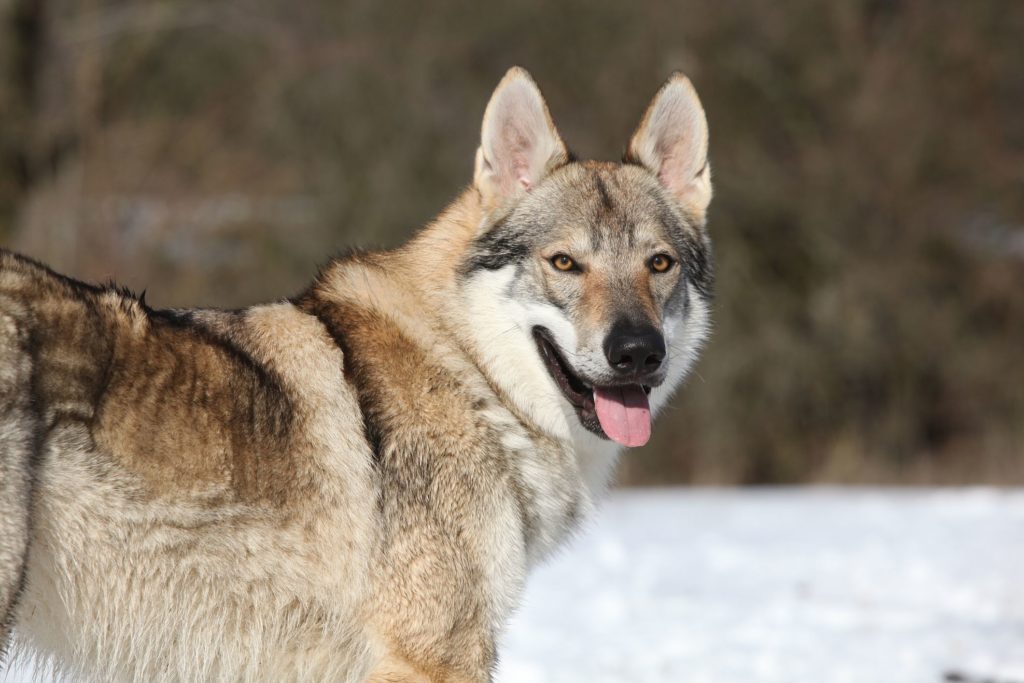
The Wolfdog, often referred to as a “wolf hybrid,” occupies a unique space between the wild and domestic worlds. Born from the union of a domestic dog and a wolf, these hybrids possess an intriguing blend of characteristics that make them both captivating and challenging companions. However, understanding the complexities of the Wolfdog requires a balanced perspective that acknowledges both their innate wild instincts and their potential for companionship.
Wolfdogs are a product of selective breeding between wolves and domestic dogs. The goal is often to merge the wolf’s wild attributes with the dog’s familiar traits. Their appearance can vary widely, reflecting the diversity of wolf and dog breeds used in their lineage. This variability extends to their behavior, as each Wolfdog inherits a unique combination of traits.
The fact that the Wolfdog’s parentage is directly traceable to actual wolves will explain why it is regarded as one of the dangerous dog breeds. These instincts can manifest as heightened sensitivity to their environment, a strong prey drive, and an inclination to establish territories. Such behaviors, while adaptive in the wild, can pose challenges in a domestic setting. Owners must be prepared to manage these instincts through responsible ownership and proper training.
Wolfdogs often require experienced handlers who are familiar with their specific needs. They demand a high level of socialization from an early age to mitigate potential behavioral issues. Their sensitivity to stimuli and tendency to form strong bonds with their human companions make them both rewarding and demanding pets.
The ownership of Wolfdogs is subject to legal restrictions and regulations in various jurisdictions due to their potential danger and the ethical concerns surrounding the hybridization of wild and domestic animals. Owning a Wolfdog requires a deep commitment to their well-being, understanding their unique traits, and providing them with an environment that suits their needs.
It’s important to emphasize that each Wolfdog is an individual, shaped by their genetics, environment, and upbringing. While some Wolfdogs may exhibit more wolf-like behaviors, others may display a stronger resemblance to domestic dogs. Understanding the Wolfdog’s heritage can help owners tailor their care to suit the specific needs of their particular hybrid.
8. Dogo Argentino
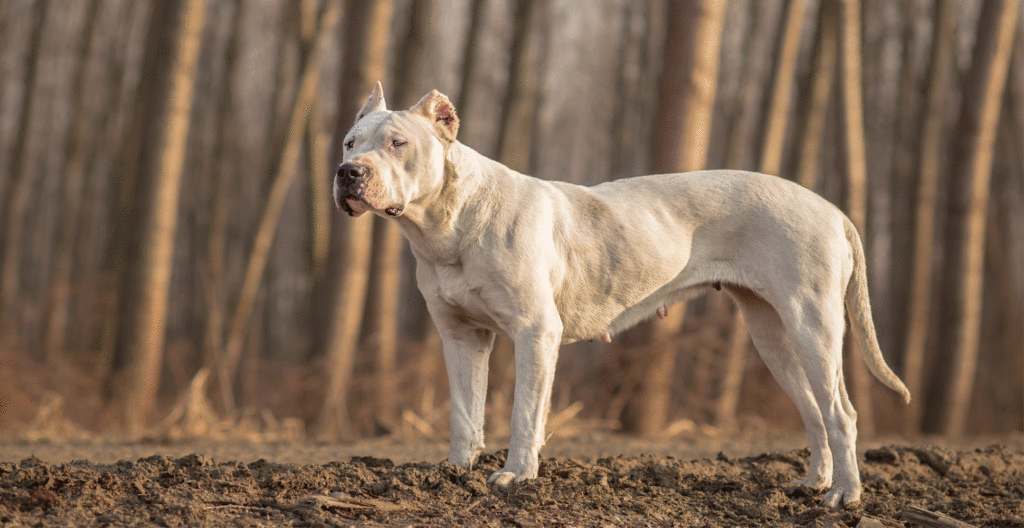
The Dogo Argentino, known for its majestic appearance and steadfast loyalty, is a breed that emerged from the fertile lands of Argentina. Bred for its exceptional hunting skills and dedication, this breed is a testament to the vision of Dr. Antonio Nores Martinez, who aimed to create a versatile canine capable of hunting big game and being a devoted family companion.
Originating in the mid-20th century, the Dogo Argentino was developed by crossing various breeds including the Cordoba Fighting Dog, Great Dane, Boxer, and Spanish Mastiff, among others. The aim was to create a breed that embodied fearlessness, strength, and the ability to work alongside humans, particularly in hunting big game such as wild boars and pumas.
The Dogo Argentino is characterized by its strong and muscular build, short white coat, and a distinctive dark nose. Its physical attributes are matched by its powerful presence and confident demeanor. While the breed’s purpose was initially focused on hunting, its loyal and protective nature has made it a cherished family companion.
A look at the Dogo Argentino’s history as a big game hunter will explain why it often features when dangerous dog breeds are being listed. The breed’s tenacity and determination when faced with dangerous prey can sometimes be misconstrued as a potential threat to humans. However, with proper socialization, training, and responsible ownership, the Dogo Argentino often demonstrates its loyalty, affection, and gentle nature toward its family members.
Responsible ownership plays a pivotal role in nurturing a well-adjusted Dogo Argentino. Early socialization is essential to ensure they are comfortable around other animals and people. Consistent and positive reinforcement-based training helps them channel their energy into positive behaviors. When provided with proper guidance, they thrive as devoted and well-mannered companions.
The Dogo Argentino’s versatility has made it adaptable to various roles beyond hunting. Many are successful in dog sports, search and rescue, and even as therapy dogs. Their loyalty, intelligence, and eagerness to please make them excel in a range of activities when raised in a loving and structured environment.
9. Boerboel
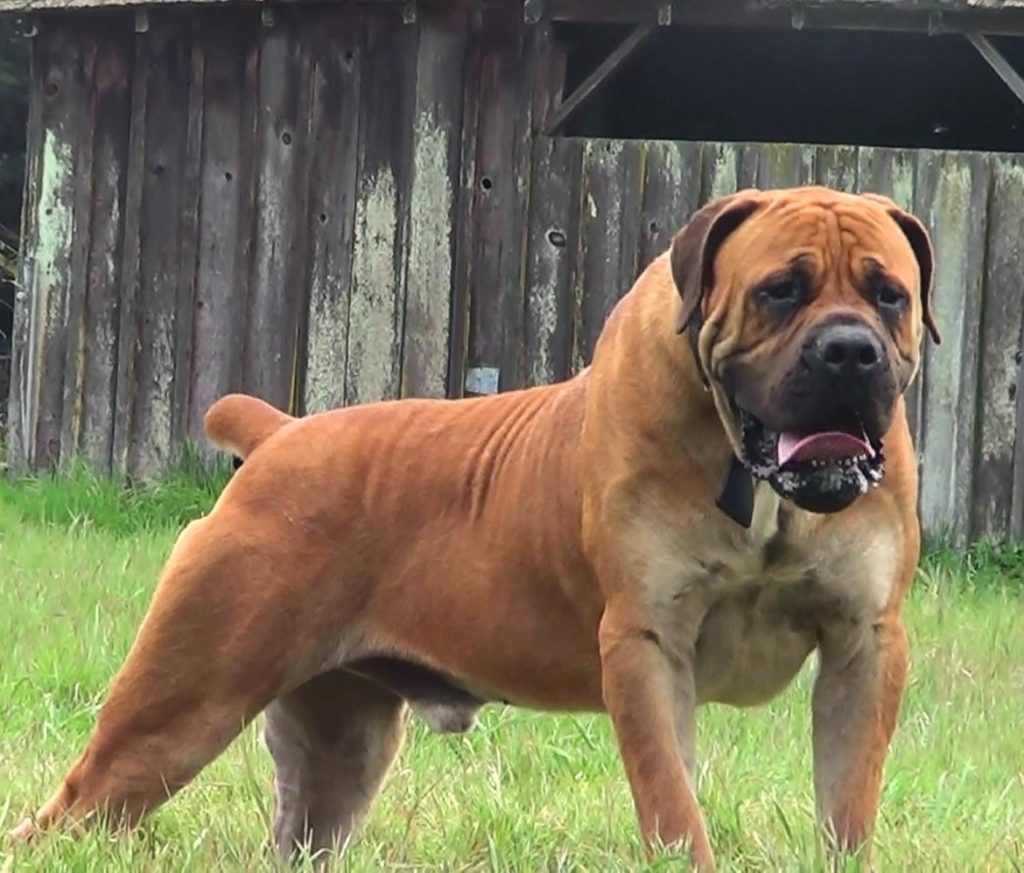
The Boerboel, often referred to as the “South African Mastiff,” is one of the breeds commonly regarded as one of the dangerous dog breeds. It is a breed that embodies strength, loyalty, and a rich history deeply rooted in South Africa. Originating from a need for a reliable farm and homestead guardian, the Boerboel has evolved into a breed that is not only a powerful protector but also a gentle and affectionate companion.
The Boerboel’s history traces back to the 17th century in South Africa, where European settlers required a robust and versatile guardian to protect their farms and families from predators and intruders. Through careful breeding, native African dogs were crossed with European breeds, resulting in the Boerboel’s distinctive attributes that combined strength, agility, and loyalty.
The Boerboel’s impressive size, muscular build, and distinctive loose skin make it stand out among other breeds. Their short coat, which can come in various colors, adds to their striking appearance. While their imposing stature reflects their guarding heritage, their eyes often convey a calm and watchful demeanor.
The Boerboel’s reputation for being a guardian stems from its history of protecting farms and families from a range of threats. Their innate loyalty and protective nature make them excellent watchdogs. While their perceived danger can stem from their imposing appearance, responsible ownership and proper socialization are crucial to ensure they remain well-mannered companions.
Early socialization plays a pivotal role in the development of a balanced Boerboel. Proper exposure to different environments, people, and animals helps them become confident and well-adjusted. Positive reinforcement training methods are essential to channel their protective instincts into controlled and appropriate behaviors.
Modern Boerboels continue to carry their historical traits while adapting to contemporary roles as family companions and protectors. Many excel as therapy dogs, service animals, and even participate in various dog sports. Their gentle and affectionate nature with their families is a testament to their ability to balance their protective instincts.
10. American Pit Bull Terrier
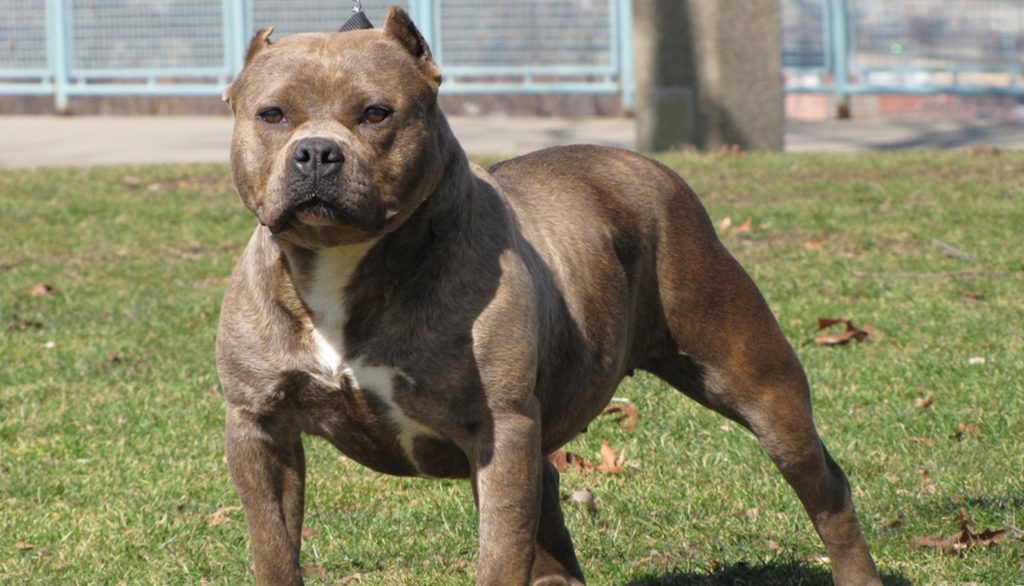
The American Pit Bull Terrier, often simply called the “Pit Bull,” is a breed that elicits a wide range of emotions and opinions. Originating from the United States, this breed has a history rooted in utility and versatility. Despite its loyal nature and remarkable qualities, the American Pit Bull Terrier is a breed often surrounded by controversy and misconceptions.
The American Pit Bull Terrier’s lineage can be traced back to 19th-century England, where it was developed from a blend of terriers and bulldogs. Initially used for hunting and controlling vermin, this breed’s athleticism, strength, and determination soon found them in the realm of bull-baiting and later dogfighting. Their strong work ethic and loyalty endeared them to families, particularly in the United States.
The American Pit Bull Terrier is characterized by its muscular build, short coat, and varied coat colors. Their appearance often reflects their athletic prowess and strength. While their physique is notable, it’s their loyalty and affection for their families that truly defines them.
The American Pit Bull Terrier’s reputation as one of the known dangerous dog breeds is largely rooted in its history as a fighting dog. However, responsible breeding and proper socialization have led many modern Pit Bulls to be friendly, gentle, and devoted companions. Their loyalty to their families and their eagerness to please make them highly trainable and affectionate pets.
Responsible ownership plays a critical role in nurturing a well-adjusted American Pit Bull Terrier. Early socialization is essential to ensure they are comfortable around other animals and people. Positive reinforcement training methods help channel their energy into positive behaviors. When provided with proper guidance, they thrive as devoted and well-mannered companions.
Today’s American Pit Bull Terriers encompass a range of temperaments and abilities. Many are cherished family pets, therapy dogs, and even participate in dog sports. Their versatility and potential to excel in various roles showcase their innate intelligence and resilience.
Conclusion of Dangerous Dog Breeds
This article has focused on looking at what we consider 10 of the most dangerous dog breeds. However, these breeds, often labeled as such due to historical roles and innate traits, demand our careful attention and understanding. While they may not be classified as adorable dog breeds, they certainly do have their merits.
As we delved into the histories and characteristics of breeds like the American Pit Bull Terrier, Dogo Argentino, and Cane Corso, we unearthed important information that shapes their perceived danger. Interestingly, their formidable reputations also make them the best guard dog breeds. This underscores their protective instincts, which responsible ownership, training, and early socialization can hone into great traits in guard dogs.
Through this exploration, it has become evident that these breeds, despite their potential challenges, deserve fair consideration beyond the confines of their labels. We recognize that beneath the perceived danger lies the potential for loyalty, and even companionship.
